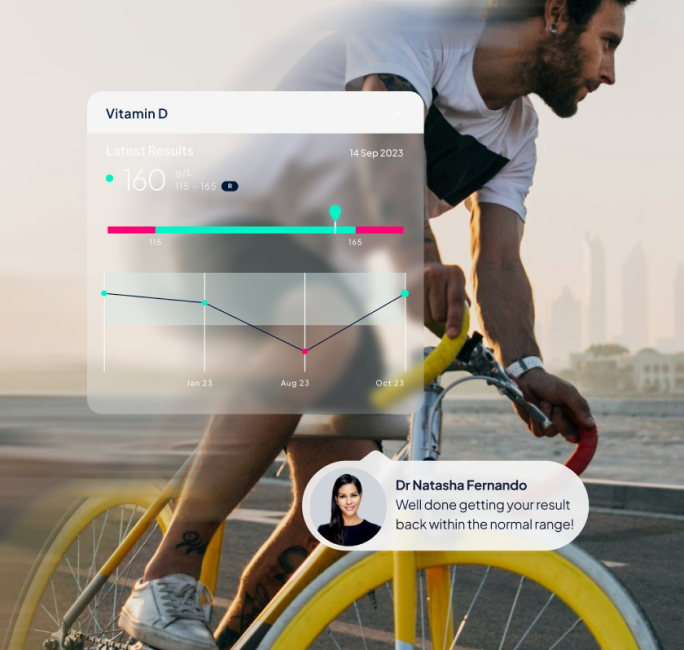Our Driver's Lifestyle Blood Test is designed for those who spend long hours on the road. It checks key markers to identify issues like fatigue, stress, or early signs of chronic conditions. With a comprehensive overview tailored to a driver's lifestyle, this test helps you maintain focus, energy, and long-term well-being.

Go beyond the numbers
Get ready to elevate your health understanding with a personalised doctor's report. Go beyond results and tap into expert insights tailored just for you.
- Actionable advice
- Expert support
- Tailored recommendations

How it works
You have the flexibility to choose what works best for you. Enjoy the comfort of having a friendly nurse visit your home for a quick blood draw, opt for a convenient visit to one of our nationwide partner clinics, or self-arrange a draw at a location that suits you.
Take control of your health with Medichecks – order your blood test today!

Track, improve, and monitor your health over time.
MyMedichecks is your personal online dashboard where you can view your results, access clear and simple explanations about individual health markers, monitor changes in your health, and securely store information about your medical history, lifestyle and vital statistics.
What's in the test?
Cholesterol status
Total cholesterol
Learn more
LDL cholesterol
Learn more
Non-HDL cholesterol
Learn more
HDL cholesterol
Learn more
Total cholesterol : HDL
Learn more
Triglycerides
Learn more
Clotting status
Platelet count
Learn more
MPV
Learn more
Diabetes
HbA1c
Learn more
A raised HbA1c result points to diabetes or an increased risk of developing diabetes, which can have a significant impact on your lifespan and quality of life. Complications of uncontrolled diabetes include heart disease, kidney disease, eye problems, and vascular conditions. It can also contribute to mental health problems. And men with diabetes are three times more likely to have erectile dysfunction. Keeping your HbA1c within a normal range can help you reduce the risk of these conditions.
Inflammation
hs-CRP
Learn more
Iron status
Iron
Learn more
TIBC
Learn more
UIBC
Learn more
Transferrin saturation
Learn more
Ferritin
Learn more
Kidney health
Urea
Learn more
Creatinine
Learn more
eGFR
Learn more
Liver health
Bilirubin
Learn more
ALP
Learn more
ALT
Learn more
Gamma GT
Learn more
Proteins
Total protein
Learn more
Albumin
Learn more
Globulin
Learn more
Red blood cells
Haemoglobin
Learn more
Haematocrit
Learn more
Red cell count
Learn more
MCV
Learn more
MCH
Learn more
MCHC
Learn more
RDW
Learn more
Vitamins
Vitamin B12 - active
Learn more
Vitamin D
Learn more
Despite its name, vitamin D is actually a hormone that’s produced by your skin when it’s exposed to sunshine. Before your body can use vitamin D produced by sun exposure (known as vitamin D3), it must be converted into another form called 25 hydroxycholecalciferol (25 OH). Vitamin D (25 OH) is the major circulating form of vitamin D, and so your vitamin D (25 OH) level is considered the most accurate indicator of vitamin D supply to your body.
Vitamin D is essential for healthy bones and teeth, as it helps your body absorb calcium. It also plays a role in muscle health, immune function, and mental health.
Low vitamin D symptoms include muscle weakness, mood swings, and fatigue. Many people in the UK have low vitamin D levels, and people with dark skin and people who don’t spend much time outdoors are particularly at risk.
Small amounts of vitamin D can be obtained from food, especially oily fish, eggs, and vitamin-D fortified foods. But if you have a vitamin D deficiency, you’re unlikely to be able to improve your levels by food alone.
White blood cells
White cell count
Learn more
Neutrophils
Learn more
Lymphocytes
Learn more
Monocytes
Learn more
Eosinophils
Learn more
Basophils
Learn more
How to prepare for your test
Prepare for your Driver's Lifestyle Blood Test by following these instructions. Take this test when any symptoms of short-term illness have settled. Avoid heavy exercise for 48 hours beforehand. Avoid fatty foods for eight hours before your test, you do not need to fast. Stay well hydrated before your test. Take your sample at least 24 hours after any vitamin or mineral supplements. Do not take biotin supplements for two days before this test, discuss this with your doctor if it is prescribed. Do not take vitamin B12 for two weeks prior to this test. If your B12 is prescribed ask your doctor whether to stop.




